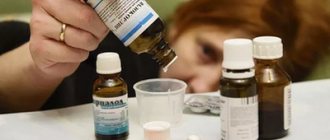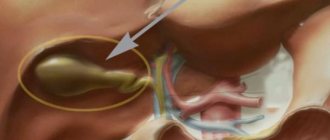ALLERGIC RHINITIS
This is a common childhood disease, which in some cases is misdiagnosed as infectious. Etiological allergens are predominantly of inhalation and bacterial origin, but they can also be food agents (eg, cow's milk in infants). The disease has two forms of clinical course.
1. Seasonal allergic rhinitis (so-called “seasonal runny nose”). The most common allergens in this case are pollen, mold, house dust, etc. Polinosis, i.e., seasonal runny nose caused by pollen, is caused mainly by tree pollen in the spring, and by grass pollen in the summer and early autumn. Seasonal allergic rhinitis, caused by mold, appears towards the end of summer and during the fall.
Clinic. They are characterized by the appearance of attacks of severe repeated sneezing, the release of abundant serous-mucosal secretion and a feeling of nasal congestion. With polynosis, the eyes are often affected - swollen eyelids, conjunctivitis and lacrimation. Sometimes prodromal phenomena are observed, which last 3-5 days and are accompanied by a feeling of itching in the nose, eyes, and less often in the ears and throat, after which an attack develops. Rhinoscopic examination reveals swelling and cyanosis of the nasal mucosa. Eosinophilia is noted in nasal secretions.
Differential diagnosis of hay fever is carried out with viral rhinitis, vasomotor rhinitis and persistent allergic rhinitis. Viral rhinitis is short-lived and rarely recurs. Vasomotor - provoked by sharp temperature fluctuations, there are no eosinophils in the nasal smear, and the Rhiecker test and CAP are negative. For the correct diagnosis of seasonal rhinitis, the appearance of sneezing attacks and runny nose during flowering of plants, an objective finding in the nose and a positive result in allergy skin tests, PACT, etc. are of great importance.
2. Persistent allergic rhinitis continues all year round. Typically, there is a decrease in symptoms in the summer and an increase in winter, when the child spends a longer time in the apartment and is exposed to certain household allergens - inhalation (house dust, household insects, daphnia, fluff), bacterial and, less often, food.
Clinic. It is characterized by a constantly stuffy nose, short bouts of sneezing, itchy nose and runny discharge for 2 to 3 weeks. Attacks are more frequent in the morning, when getting out of bed, lasting 15-30 minutes, after which a painful feeling of nasal congestion remains. Children often blow their nose, scratch and pick their nose; peculiar tics of the wings of the nose and unusual facial expressions are noted. Rhinoscopy reveals swollen, pale bluish mucosa, often covered with purulent mucous secretion. Eye symptoms are absent or mildly expressed.
The diagnosis is made on the basis of anamnestic data, rhinoscopic examination and the presence of eosinophilia in nasal secretions.
In the differential diagnostic relation, one should also keep in mind infectious rhinitis, deviated nasal septum, foreign body entry into the nose and hypertrophied adenoid growths. With infectious rhinitis, the child’s temperature rises, purulent mucous discharge, the nasal mucosa is severely hyperemic, the Rhiecker test and other allergy tests are negative. With a foreign body in the nose, one-sided obstruction is also noted, but a mucous-bloody secretion is released. Hypertrophied adenoid growths cause constant incomplete obstruction, the child snores at night, speaks through his nose and often suffers from otitis media. Consultation with a laryngologist will help make an accurate diagnosis.
Frequent complications are: infectious rhinitis, sinusitis, laryngitis, recurrent otitis and adenoiditis, and the most severe complication is bronchial asthma, which is observed in 20-40% of cases.
Treatment in the acute attack period is carried out with ephedrine or adrenaline in the form of drops or ointments, as well as antihistamines and corticosteroids orally and locally. For seasonal allergic rhinitis, specific hyposensitization (SH) should begin in December. If the child is late with pre-season treatment, then express SG methods are used, which include the Hansen method - daily injections are given a month before the start of the season. During the season itself, the Freeman method is used; the child is hospitalized and injections are made every 2 hours (7 times a day) in increasing doses; The P. Blamoutier method is also used, which consists of applying finger extracts to the place of a scarification mesh (mutually intersecting scarifications) the size of a child's palm for 30 - 60 minutes, after which they are washed off and the procedure is repeated 15 days later during the season. Recently, with seasonal rhinitis lasting 1 - 2 months, it is recommended to take the child to those areas where the flowering of plants has finished. In case of persistent allergic rhinitis, except for SG, if there are foci of local infection, then they must be sanitized.
Instrumental diagnostics
Of course, examination and laboratory tests give doctors the opportunity to suspect the presence of a particular disease. However, to make an accurate diagnosis, additional procedures are performed:
- X-ray of the lungs allows you to determine the presence of foci of inflammation, determine their size, quantity, location;
- angiopulmonography is a procedure that allows you to examine the functioning of blood vessels and is performed if thromboembolism is suspected;
- bronchography and bronchoscopy are carried out to check the functioning of the bronchi, detect certain anatomical disorders, neoplasms, etc.;
- A CT scan of the lungs allows the doctor to obtain three-dimensional images of the respiratory organs, assess their condition, and detect certain disorders.
ALLERGIC RHINOSINUSITIS
This disease very often accompanies allergic rhinitis (73%) and bronchial asthma (41.5%) (L. Basheva, Pryvchev and coll.). The establishment of allergic rhinosinusitis (ARS) is important, as it causes the development of infection in the sinuses and bronchi with subsequent increased sensitization. The most common allergens that cause this rhinosinusitis are allergens of bacterial and inhalation origin. They develop in children from 3 to 10 years of age, localized in the maxillary and ethmoid sinuses on one or both sides.
Their clinical picture is as follows: prolonged and often worsening runny nose in the autumn-winter seasons, cough, loss of appetite, headache and frequent otitis media. Sometimes the predominant cough is a paroxysmal cough at night or upon awakening, sharp, irritating, painful. It is explained by damage to the larynx, trachea and bronchi - the so-called sino-pharyngeal-tracheo-bronchial syndrome occurs. On examination, the nasal mucosa is cyanotic and edematous, the lower conchae are edematous and hyperplastic, the secretion is serous during exacerbation and mucopurulent in remission. X-ray reveals darkening of the maxillary sinuses - complete, parietal or cystic. Sometimes X-ray findings are the only indication of the presence of sinusitis in children with bronchial asthma.
Complications: tubotympanitis, otitis, adenitis, pharyngitis, laryngitis, tracheobronchitis, recurrent bronchopneumonia and bronchial asthma.
Treatment is the same as for chronic rhinitis, local, restorative, specific and nonspecific hyposensitization. It is important to remove the adenoids in a timely manner and use long-term climatotherapy in the autumn-winter season in a sanatorium, combining it with SG in relation to the allergenic factor.
To give up smoking
Smoking is the most formidable enemy of respiratory health. Smokers are much more likely than non-smokers to suffer from chronic bronchitis (there is even a separate form of this disease - smoker's chronic bronchitis), and they develop lung cancer 15 to 30 times more often than people who do not have this bad habit. The latter, however, can be passive smokers if they are near a smoking person. They inhale the harmful substances released by them, and they harm them to the same extent, and possibly more.
So, in the process of smoking, nicotine and toxic tars enter the human body. Day after day, year after year, they have a damaging effect on the mucous membrane of the respiratory system, disrupting the functioning of its cells, and in some cases causing their malignant degeneration.
That is why the main preventive measure against respiratory pathology is to give up this bad habit. Moreover, it is complete refusal that is important, and not reducing the number of cigarettes smoked or switching to cigarettes with less nicotine content.
When a person quits smoking, the likelihood of developing respiratory tract diseases decreases from the first days. 5-10 years after quitting smoking, the risk of lung cancer is equal to that of non-smokers.
ALLERGIC LARINGITIS
The course of allergic laryngitis (AL) can be acute or chronic.
1. Acute AL is observed in 65% of all patients with laryngitis (Hansel). Etiological allergens in children under three years of age are most often food and infectious factors, and later - inhalation and household factors. Less commonly, they are medicinal substances such as aspirin, analgin, quinine, etc. The disease occurs either suddenly, or 1 - 2 days after acute nasopharyngitis with attacks of dry, frequent, irritating, typically barking cough with inspiratory dyspnea, jugular and epigastric retraction, and in more severe forms with cyanosis of the lips. Usually this is accompanied by an exacerbation of vesicular breathing, and sometimes rough moist rales in the upper part of the chest. Laryngoscopy reveals swelling of the mucous membrane in the subchordal space, and sometimes swelling of the glottis and uvula. Over the following nights the attacks become milder or stop altogether, only to recur again after a few months.
In differential diagnostic terms, one should keep in mind viral and diphtheria laryngitis, a foreign body in the pharynx and laryngospasm observed with rickets. Viral laryngitis can be of influenza, measles, etc. origin. Acute respiratory disease occurs with high fever and rarely recurs. With diphtheria, aphonia intensifies, suffocation and cyanosis gradually and progressively develop, nocturnal attacks are observed, the child is severely intoxicated; sometimes the tonsils are covered with dirty gray films.
With a foreign body in the larynx, nocturnal attacks of suffocation are not typical and the issue is resolved directly during laryngoscopy. Laryngospasm during rickets occurs suddenly in a severe form, regardless of the time of day: an attack of apnea with painfully noisy and prolonged inhalation, often accompanied by hiccups. The voice is clear and there is no cough. Chvostek and Truso's symptoms are positive, the amount of calcium in the serum is reduced.
During an attack, treatment is carried out in a hospital, in a calm environment, inhalations are made with a 5% solution of baking soda and adrenaline, antihistamines (AGP) and corticosteroids are used orally and intramuscularly. Treatment lasts 5 - 7 days. 3 weeks after recovery, skin allergy tests are performed. If attacks recur, then SG or treatment with histoglobin is performed (for 1-2 months).
2. Chronic AL develops in school-age children, most often suffering from chronic sinusitis. There are catarrhal and polypous forms of AL. In the first case, the process is limited in the area of the true vocal cords, and in the second case, small polyposis growths are noted on the medial side of the vocal cords. Symptoms do not differ from those of ordinary chronic laryngitis: irritation of the larynx, accompanied by frequent mild coughing, decreased sonority of the voice and dysphonia, manifested to varying degrees. The diagnosis is clarified by laryngoscopy and by assessing the results of allergy tests.
Pharyngitis
This disease is much less dangerous compared to a sore throat, however, it can also cause a lot of trouble and definitely will not make your life easier. This disease is characterized by the fact that it also has a direct effect on the upper respiratory tract, and its symptoms are in some ways similar to sore throat, but much less pronounced. So, touching upon the symptoms of pharyngitis, the following are distinguished:
- Painful sensations in the throat when swallowing;
- In the area of the pharynx, there is a feeling of soreness and dryness of the mucous membrane;
- There is a slight increase in temperature, but rarely above 38 degrees thermometer;
- The palatine tonsil and nasopharyngeal mucosa are inflamed;
- In especially severe and advanced cases, purulent formations may appear on the back wall of the pharynx.
Diagnosing rhinitis is somewhat more difficult than sore throat, since the symptoms of this disease are less pronounced. However, as soon as you feel pain in your throat when swallowing, or notice even a slight increase in temperature or general malaise, you should consult a doctor.
Speaking about the treatment of this disease, it will be less severe than with a sore throat, if only for the simple reason that you are unlikely to have to take antibiotics. If you have pharyngitis, you should completely avoid inhaling cold air, smoking (both passive and active), eating food that irritates the mucous membrane, that is, eliminating spicy, sour, salty, and so on from the diet.
The next step will be methodically rinsing the eagle with special pharmaceutical preparations, or infusions of medicinal herbs such as sage, chamomile or calendula. Another great rinse method is to mix a teaspoon of salt and half a teaspoon of baking soda in a glass of warm water, and add a few drops of iodine. Such treatment helps relieve pain, relieve soreness and inflammation, as well as disinfect the upper respiratory tract and prevent the formation of purulent deposits. It would also be useful to take antibacterial drugs, however, it is better to consult a specialist on this matter.
ALLERGIC TRACHEITIS
It is rarely observed as a separate disease. More often accompanied by allergic rhinitis or rhinosinusitis. Allergens are the following agents: bacterial origin, household inhalation, tobacco smoke, etc. The disease can occur after the age of four.
Its clinical picture is expressed in a persistent and prolonged cough, lasting from 3 to 10 months - from October to March. Most often it occurs in the fall. The cough has a paroxysmal character - spastic, dry, rough, sometimes barking in nature, lasting up to one hour, exhausting the sick child. Sometimes the attack is accompanied by a burning sensation and itching. During the study, no changes in the lungs were noted. Bronchoscopically, the tracheal mucosa is swollen and pale yellow. Eosinophilia is often detected in the blood and in nasal secretions, and a skin allergy test reveals sensitivity to household and bacterial allergens. X-ray of the lungs shows no changes.
Differential diagnosis is made with whooping cough, synobronchitis, the presence of a foreign body in the trachea and esophagus, as well as extra- and intratracheal neoplasms. The correct diagnosis is facilitated by fluoroscopic examination, tracheoscopy, assessment of epidemiological data and the results of special specific studies on allergic diseases.
Treatment is effective if the causal allergen is eliminated and appropriate specific hyposensitization is carried out. When coughing attacks become more frequent, a good effect is achieved by treatment with corticosteroids for one month.
Primary diagnosis
Respiratory diseases are varied, so various procedures are performed during diagnosis.
- As a rule, the doctor first takes an anamnesis and collects information about symptoms.
- Auscultation allows the specialist to hear uncharacteristic wheezing in the lungs.
- Percussion (tapping) is a procedure that is performed in order to determine the boundaries of the lungs and find out how much their volume is reduced.
- A general examination (for example, examination of the throat) is performed.
- The patient gives a blood test - such testing allows you to determine the presence of an inflammatory process in the body.
- For testing, sputum samples are taken, which are then examined for the presence of antipyretic cells. Bacteriological culture is also carried out, which will allow us to isolate the causative agent of the disease and determine the effectiveness of the drugs.
ALLERGIC BRONCHITIS
There are two forms: eosinophilic and chronic allergic bronchitis: 1. The first occurs in infancy and preschool age (Hoffman, Gubo). Caused by mold, bacterial and inhalant allergens. The pathogenesis is identical to bronchial asthma, but with allergic bronchitis, bronchospasm is either mild or absent. The disease begins with a runny nose, copious liquid secretions, a persistent, frequent, whooping cough that occurs at any time of the day, with tachydyspnea, but without attacks of suffocation. Dry and moist wheezing is noted in the lungs. There is pronounced eosinophilia in the blood and sputum. Radiologically, there are no changes in the lungs, but bronchoscopy reveals a slight expansion of the bronchial tree, redness of the mucosa, which is abundantly covered with glassy mucus. Allergy skin test is positive for mold and bacteria. Differential diagnosis includes whooping cough, parawhooping cough, synobronchitis and recurrent bronchitis. Treatment in the acute phase is with calcium antihistamines, but lasting results are achieved only with SG.
2 Chronic allergic bronchitis is more common in preschool children and develops after pneumonia and tracheobronchitis. It is characterized by a prolonged cough, lasting 5-6 months, dry or wet, in the autumn-winter period, untreatable with antibiotics and expectorants; worsens after physical exertion and in the evenings after going to bed. During auscultation, acute breathing is heard with moist wheezing, and sometimes dry and tender. In this case, the ESR is slightly accelerated, leukocytosis is absent, but eosinophilia is noted in the blood and sputum. Allergy skin testing is usually positive for bacterial and household allergens. According to Glasser, Hodex, 40% of children suffering from the disease during puberty develop asthma, so they need treatment for FH, which gives very good results.
Differential diagnosis is carried out taking into account allergic tracheitis, sinubronchitis and chronic recurrent non-allergic bronchitis.
Treatment of respiratory diseases
Chronic and acute bronchitis is sometimes treated with antibiotics, and anti-inflammatory drugs and vitamins are also prescribed. The effectiveness of the herbal components used is high, with a bronchodilator and secretolytic effect. Saponins of primrose roots and ivy leaves exhibit secretolytic properties, flavonoids and essential oils of thyme herb have secretolytic and bronchodilator properties. relax Smooth muscles of the bronchi relax under the influence of biologically active substances of ivy, which prevents the development of bronchospasm. The antibacterial effect is carried out using thymol, which is part of thyme essential oil. It is more effective to carry out treatment when professional and harmful household influences have been eliminated: it is useful to change the profession and climate.
Healthy lifestyle
A healthy lifestyle is the basis for the prevention of respiratory diseases.
A healthy lifestyle ensures high resistance of the human body to adverse external factors, improves the functioning of both local and general immunity. It includes:
- physical activity (walking in the fresh air, daily exercise, swimming, cycling or any other activity);
- a rational regime of work and rest (overwork does not benefit anyone; timely rest and healthy seven to eight hours of sleep at night make our body stronger and in the same way affect the immune system);
- rational and balanced nutrition (containing all the nutrients, vitamins, microelements, amino acids, etc. necessary for the body to function properly);
- hardening (you shouldn’t raise children in “greenhouse” conditions, you need to gradually accustom them to the effects of unfavorable factors - cool water, air; you should walk every day and in any weather, but in suitable clothing to avoid overheating, hypothermia or getting wet).










